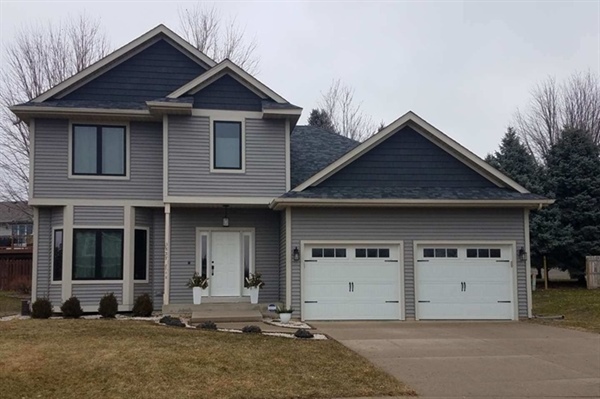Vinyl vs. Fiber Cement vs. Engineered Wood: Which Siding Is Best for Minnesota Homes?

Vinyl, fiber cement, and engineered wood each bring distinct advantages to Minnesota’s varied climate—from subzero winters to humid summers—and choosing the right option means balancing durability, appearance, and maintenance.
Steve Gentry Construction helps Rochester homeowners navigate these choices, ensuring their homes stay protected and beautiful year-round. By comparing materials side by side and exploring industry-leading techniques, you’ll gain the insight needed to make a confident decision on siding that lasts.
Let's explore some key topics every homeowner should consider when selecting the best siding for their home’s needs and personal priorities.
Comparing Durability: Performance of Vinyl, Fiber Cement, and Engineered Wood in Minnesota’s Climate
Vinyl siding resists moisture absorption and won’t rot or warp during spring thaw and summer storms. Modern formulations include UV inhibitors that reduce fading under harsh sun, and locking systems prevent panel separation during high winds. Impact resistance has also improved, with thicker panels now able to withstand hailstones and airborne debris.
Fiber cement siding combines cement, sand, and cellulose fibers to create a dense, fire-resistant product. It resists cracking from freeze-thaw cycles and stands up to impact better than traditional vinyl. Its non-organic composition eliminates termite risk, and factory-applied finishes now carry warranties against chalking and peeling.
Engineered wood siding features a plywood or strand-woven core treated against moisture and insects, overlaid with a durable finish. It offers an authentic wood grain but requires precise installation to seal joints. When properly painted and caulked, it endures Minnesota winters without splitting, though heavy ice or hail may cause surface dents. Selecting the right installer ensures maximum performance from each material—start your project with expert advice on siding.
Maintenance Requirements: Long-Term Care for Vinyl, Fiber Cement, and Engineered Wood
Vinyl siding demands minimal upkeep. Annual power rinsing removes dirt, pollen, and mold. Homeowners should inspect trim and caulk around windows and doors every two years to maintain water resistance. Fading and chalking are rare with quality brands, though boards can be replaced easily if damaged.
Fiber cement requires repainting every 15 to 20 years, depending on finish quality and exposure. Joint sealants should be checked every five years to prevent water intrusion. Its hard surface resists dents, but power washing at low pressure is recommended to avoid surface erosion.
Engineered wood needs the most attention. A fresh coat of paint or stain every 7 to 10 years preserves the surface seal. Inspect for cracks at seams annually and reapply exterior sealant as needed. Treated cores resist termites, but caulking and paint film integrity are critical to prevent moisture entry and decay.
Cost Breakdown: Initial Investment vs. Lifetime Value of Siding Materials
Vinyl siding ranges from $2 to $7 per square foot installed. Labor is straightforward and materials are lightweight, which keeps upfront costs low. Over a 25-year lifespan, minimal maintenance and rare replacement panels offer good value.
Fiber cement runs $5 to $10 per square foot installed. Higher material and labor costs reflect its density and weight. When factoring in a 30-year finish warranty and negligible insect or rot concerns, the total cost per year aligns closely with vinyl while providing enhanced fire resistance.
Engineered wood sits between $4 and $8 per square foot. Installation demands careful flashing and sealing, so labor rates can match fiber cement. Maintenance costs for painting and caulking should be included in lifecycle calculations. Many homeowners find the authentic wood appearance offsets higher long-term servicing expenses.
Aesthetic Differences: Style Options and Curb Appeal Considerations for Each Siding Type
Vinyl siding offers a broad palette of factory-applied colors and profiles—from traditional clapboard to modern board-and-batten. Color retention has improved, though deep hues may fade faster in direct sun. Decorative trim and accessories allow customization without additional painting.
Fiber cement mimics wood grain, stucco, or masonry textures. It accepts factory and field painting, giving homeowners the flexibility to change palettes over time. Clean lines and crisp edges accentuate architectural details, whether modern, craftsman, or farmhouse styles.
Engineered wood delivers authentic wood grain and shadow lines. Pre-finished and field-paintable options allow for rich color choices. Its depth and texture provide natural warmth and curb appeal that few synthetic products can match, making it a popular choice for historic and high-end homes.
Environmental Impact and Energy Efficiency of Vinyl, Fiber Cement, and Engineered Wood
Vinyl siding is produced from PVC, which can be recycled at the end of its life, but it relies on nonrenewable resources. Its low thermal conductivity reduces heat loss, especially when combined with insulated foam backer boards. This can lower heating costs by 5–10 percent in cold climates.
Fiber cement’s raw materials are abundant and noncombustible. Although manufacturing consumes more energy than vinyl, its longevity and lack of repainting reduce overall environmental impact. When paired with cavity insulation, it contributes to consistent indoor temperatures.
Engineered wood uses smaller logs and wood residues, maximizing forest resources. Many brands source from certified sustainable forests. Its R-value per inch falls between vinyl and fiber cement, and reflective coatings can improve energy performance.
Contact Steve Gentry Construction for Expert Siding Solutions
Steve Gentry Construction brings over two decades of siding expertise to Minnesota homes. Whether your priority is ultimate durability, minimal upkeep, budget optimization, standout curb appeal, or green building goals, our team offers tailored recommendations based on local conditions and product performance.
Ready to discuss your siding project or schedule a free estimate? Contact us today and learn how Steve Gentry Construction can transform your home’s exterior with superior products and craftsmanship!